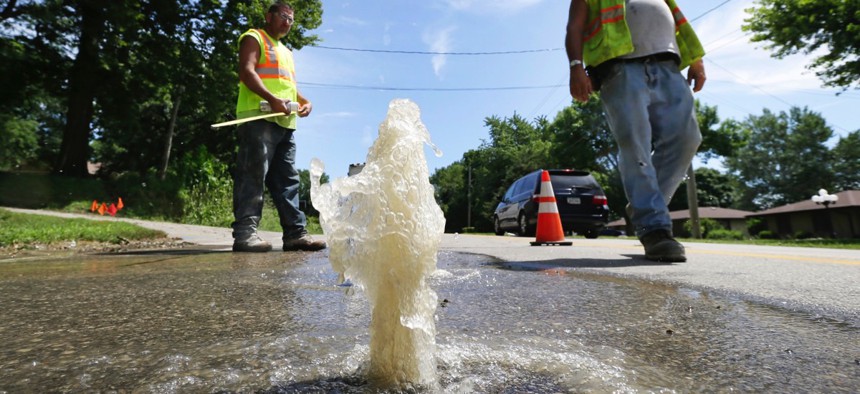Is Deferred Maintenance a Financial Time Bomb for State and Local Governments?

Des Moines Water Works employees walk past water bubbling through a hole in a street following a water main break in 2015. After decades of deferring maintenance, scores of World War II-era drinking water systems are in need of replacement. Charlie Neibergall / AP Photo

Connecting state and local government leaders
It’s hard to know because there’s not a standardized way for measuring or recording it, but a budding coalition of experts and industry leaders wants to look at ways to change that.
DALLAS — By postponing infrastructure maintenance, state and local governments could be setting themselves up for heavy financial burdens in future years—possibly creating risks for taxpayers and investors.
But it’s hard to get a handle on the scope of this problem because there is not a widely accepted standard for states and localities to report deferred maintenance. “We’re not measuring this,” Orion Fulton, a senior manager with Arup, a design, planning, engineering and consulting firm, noted at an event here this week.
Fulton is part of an emerging group that wants to look deeper into questions related to deferred maintenance. Some of the others involved in the effort are from the ratings agency Standard & Poor’s and Stanford University.
“We’re really interested in exploring this topic more,” said Michael Bennon, managing director at Stanford’s Global Projects Center. “There’s a lot of leeway that states and local governments have in recording deferred maintenance and also, kind of, assessing what that is.”
Anne Selting is an analytical manager at Standard and Poor’s who focuses on infrastructure and renewable energy.
“We’re missing something if we’re not tracking deferred maintenance,” she said Tuesday.
From a bond investor’s perspective, she explained, having a grasp on a public entity’s deferred maintenance costs is a potentially valuable piece of information for gauging risk and making decisions about where to put money.
Selting said that difficulties related to deferred maintenance are apparent “up and down the food chain” from state governments to school districts. “It is becoming a concern. There is dialogue within our organization on how do we start reflecting this in the rating?”
But there are roadblocks to answering that question, like where to get data and what to measure.
Fulton, Bennon and Selting made their comments during a discussion at the P3C Public-Private Partnership Conference & Expo, which was held in Dallas this week.
One of the points that was made during the talk is that deferred maintenance costs tend to increase exponentially over time.
Consider a leak in a government building that first results in a discolored ceiling. Rather than pay to repair the leak, it’s left unfixed to save cash in the near-term. Over time, it grows worse and eventually water damages an electric panel. The cost of the repair increases as a result.
During Tuesday’s discussion, there was mention of a decision in Long Beach, California to replace the city hall. At year 38 of its life, according to figures presented during the talk, the building had upwards of $70 million in estimated deferred maintenance.
The replacement value would have been $133 million.
But buildings are just one example. Similar situations can unfold with public assets ranging from bridges to waterworks. Why? One reason is many states and localities are working with tight budgets. As a result, maintenance is delayed so more immediate expenses can be paid for.
San Jose, California calculates and publishes deferred infrastructure maintenance estimates. The city’s backlog was pegged at around $1.5 billion in a report issued in January. San Jose has about one million residents and 2016-2017 general fund spending of roughly $1.2 billion.
“This is not normal,” Fulton said of the city’s work to chronicle deferred maintenance. “They’re actively trying to get their arms around how they manage their assets.” In San Jose’s case these assets span across categories like parks and pools, storm sewer systems, and transportation.
Infrastructure is getting attention in the U.S. presently as President Trump has identified it as one of the pillars of his economic platform. But it’s an open question to what extent his plans will help provide funding and financing for upkeep, as opposed to new projects.
Fulton said the deferred maintenance working group he and others are looking to set up would aim to have an initial workshop around May. It would likely be organized through Stanford. Among the questions the group could look at, according to Fulton: Is deferred maintenance an unfunded liability? Is it a form of borrowing? What are the data sources available on the issue?
Selting said first steps would include defining a mission statement for the group and getting reputable, independent researchers involved. Referring to the overall effort she added: “We think this is critical.”
Bill Lucia is a Senior Reporter for Government Executive’s Route Fifty and is based in Washington, D.C.

NEXT STORY: Virginia Poised to Lead on Risk Analysis of State Pension Investments





